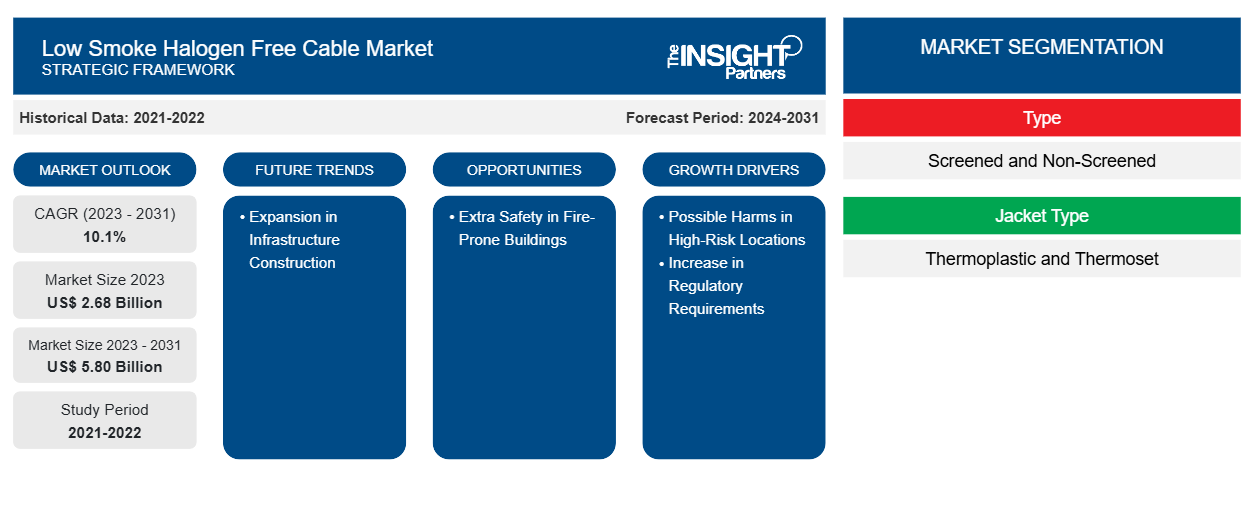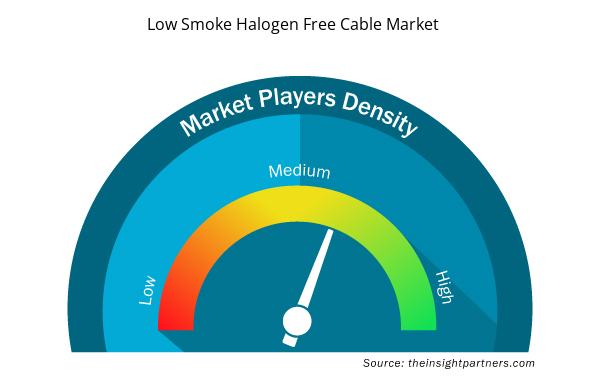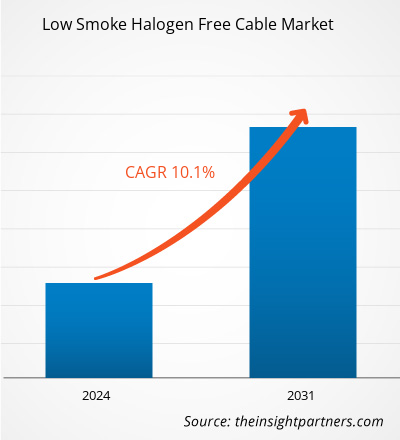The low smoke halogen free cable market size is projected to reach US$ 5.80 billion by 2031 from US$ 2.68 billion in 2023. The market is expected to register a CAGR of 10.1% in 2023–2031. Potential harms in high-risk locations and additional safety in fire-prone buildings are likely to remain market trends.
Low Smoke Halogen Free Cable Market Analysis
Low Smoke Halogen Free (LSHF) cables have become increasingly important due to their capacity to minimize equipment damage and smoke toxicity in commercial and residential building initiatives. These cables emit minimal levels of smoke and hazardous fumes and do not release acid gases when subjected to fire, setting them apart from PVC cables and those composed of other materials that generate substantial volumes of dense black smoke, harmful fumes, and acid gas.
Low Smoke Halogen Free Cable Market Overview
Low Smoke Halogen Free (LSHF) cables are a type of cable widely used in various applications where the emission of smoke and toxic fumes can pose a risk to human health and essential equipment in the event of a fire. These cables are designed to emit minimal levels of smoke and toxic fumes and do not release acid gases when exposed to fire. Unlike PVC cables and those made of other compounds, which produce substantial amounts of dense black smoke, toxic fumes, and acid gas when subjected to fire, LSHF cables offer enhanced safety features by significantly reducing equipment damage and smoke toxicity in commercial and residential building projects. The use of LSHF cables is particularly beneficial in high-risk locations and fire-prone buildings, where adherence to stringent fire compliances and regulations is essential for ensuring additional safety. The proliferation of data communication, increase in regulatory requirements, and adoption of LSHF cables in industries such as nuclear power plants contribute to the growth of the market.
Customize This Report To Suit Your Requirement
You will get customization on any report - free of charge - including parts of this report, or country-level analysis, Excel Data pack, as well as avail great offers and discounts for start-ups & universities
Low Smoke Halogen Free Cable Market: Strategic Insights

- Get Top Key Market Trends of this report.This FREE sample will include data analysis, ranging from market trends to estimates and forecasts.
Customize This Report To Suit Your Requirement
You will get customization on any report - free of charge - including parts of this report, or country-level analysis, Excel Data pack, as well as avail great offers and discounts for start-ups & universities
Low Smoke Halogen Free Cable Market: Strategic Insights

- Get Top Key Market Trends of this report.This FREE sample will include data analysis, ranging from market trends to estimates and forecasts.
Low Smoke Halogen Free Cable Market Drivers and Opportunities
Possible Harms in High-Risk Locations to Favor the Market
The increased demand for halogen-free cables in high-risk locations is a result of the risks associated with using halogenated cable materials. These materials, which contain elements such as fluorine, chlorine, and bromine, can release toxic and corrosive fumes when exposed to fire, posing significant health risks to individuals and causing damage to electronic equipment and metal structures. Consequently, the imperative to mitigate these potential harms in high-risk locations has driven the need for halogen-free cables, as the use of traditional halogenated cables in such areas could present serious safety and health hazards.
Extra Safety in Fire-Prone Buildings
The increasing need for improved safety measures in buildings and confined spaces prone to fire is fueling the rising demand for halogen-free cables. This demand is shaped by various factors, including the necessity to reduce the dangers associated with fire hazards in contemporary building designs. Modern buildings often incorporate open architecture glazing, false ceilings, and large openings, which can compromise the compartmentation needed for effective fire safety. Moreover, insufficient fire safety provisions, inadequate enforcement of building codes, and a lack of resources for maintaining active fire systems all contribute to inadequate fire safety measures within buildings, significantly elevating the risk to both life and structural integrity. Additionally, the use of traditional halogenated cables in these environments can worsen the potential harm in high-risk locations, underscoring the critical requirement for halogen-free cables to offer additional safety measures in such fire-prone settings. This trend reflects the evolving landscape of building designs and the urgency to address fire safety concerns in modern architectural structures.
Low Smoke Halogen Free Cable Market Report Segmentation Analysis
Key segments that contributed to the derivation of the low smoke halogen free cable market analysis are type, jacket type, insulation material, and application.
- Based on type, the market is bifurcated into screened and non-screened. The screened segment held a substantial market share in 2023.
- By jacket type, the market is bifurcated into thermoplastic and thermoset. The thermoset segment held a significant share of the market in 2023.
- Based on insulation material, the market is divided into polypropylene, polyethylene, thermoplastic polyurethane, and others. The polypropylene segment is expected to hold a significant share of the market in 2023.
- In terms of application, the market is segmented into building & construction, rail cars, ships, aircraft, and others. The building & construction segment is expected to hold a significant share of the market in 2023.
Low Smoke Halogen Free Cable Market Share Analysis by Geography
The geographic scope of the low smoke halogen free cable market report is mainly divided into five regions: North America, Asia Pacific, Europe, Middle East & Africa, and South America/South & Central America.
Stringent regulations and standards designed to improve fire safety in commercial and residential properties have significantly impacted the European low smoke halogen free cable market. These regulations, bolstered by ongoing research and development efforts, have played a vital role in driving the adoption of low smoke halogen free cables. The imperative nature of these rules and regulations has emerged as a primary driver for the market, mirroring evolving industry requirements and technological advancements.
Low Smoke Halogen Free Cable Market Regional Insights
The regional trends and factors influencing the Low Smoke Halogen Free Cable Market throughout the forecast period have been thoroughly explained by the analysts at Insight Partners. This section also discusses Low Smoke Halogen Free Cable Market segments and geography across North America, Europe, Asia Pacific, Middle East and Africa, and South and Central America.

- Get the Regional Specific Data for Low Smoke Halogen Free Cable Market
Low Smoke Halogen Free Cable Market Report Scope
| Report Attribute | Details |
|---|---|
| Market size in 2023 | US$ 2.68 Billion |
| Market Size by 2031 | US$ 5.80 Billion |
| Global CAGR (2023 - 2031) | 10.1% |
| Historical Data | 2021-2022 |
| Forecast period | 2024-2031 |
| Segments Covered |
By Type
|
| Regions and Countries Covered | North America
|
| Market leaders and key company profiles |
Low Smoke Halogen Free Cable Market Players Density: Understanding Its Impact on Business Dynamics
The Low Smoke Halogen Free Cable Market market is growing rapidly, driven by increasing end-user demand due to factors such as evolving consumer preferences, technological advancements, and greater awareness of the product's benefits. As demand rises, businesses are expanding their offerings, innovating to meet consumer needs, and capitalizing on emerging trends, which further fuels market growth.
Market players density refers to the distribution of firms or companies operating within a particular market or industry. It indicates how many competitors (market players) are present in a given market space relative to its size or total market value.
Major Companies operating in the Low Smoke Halogen Free Cable Market are:
- BASF SE
- BOREALIS AG
- Dow
- Fujikura Limited
- Hitachi, Ltd.
- Nexans SA
Disclaimer: The companies listed above are not ranked in any particular order.

- Get the Low Smoke Halogen Free Cable Market top key players overview
Low Smoke Halogen Free Cable Market News and Recent Developments
The low smoke halogen free cable market is evaluated by gathering qualitative and quantitative data post primary and secondary research, which includes important corporate publications, association data, and databases. The following is a list of developments in the market:
- ACL Cables creates history as the first local company to receive SLS 1504 -3-31 standard compliance for fire rate cables. Creating history and proving its dominance in the cable industry once again, ACL Cables PLC announced it had been awarded the SLS 1504-3-31 accreditation certification for its Low smoke Halogen Free (LSHF) non-sheathed cables by the Sri Lanka Standards Institution (SLSI) recently.
(Source: Lanka Business News, Newsletter, 2020)
Low Smoke Halogen Free Cable Market Report Coverage and Deliverables
The “Low Smoke Halogen Free Cable Market Size and Forecast (2021–2031)” report provides a detailed analysis of the market covering below areas:
- Market size and forecast at global, regional, and country levels for all the key market segments covered under the scope
- Market dynamics such as drivers, restraints, and key opportunities
- Key future trends
- Detailed PEST/Porter’s Five Forces and SWOT analysis
- Global and regional market analysis covering key market trends, major players, regulations, and recent market developments
- Industry landscape and competition analysis covering market concentration, heat map analysis, prominent players, and recent developments
- Detailed company profiles
- Historical Analysis (2 Years), Base Year, Forecast (7 Years) with CAGR
- PEST and SWOT Analysis
- Market Size Value / Volume - Global, Regional, Country
- Industry and Competitive Landscape
- Excel Dataset


- Quantitative Structure-Activity Relationship (QSAR) Market
- Fill Finish Manufacturing Market
- Authentication and Brand Protection Market
- Smart Mining Market
- Social Employee Recognition System Market
- Skin Tightening Market
- Skin Graft Market
- Artificial Intelligence in Healthcare Diagnosis Market
- Hair Extensions Market
- Trade Promotion Management Software Market

Report Coverage
Revenue forecast, Company Analysis, Industry landscape, Growth factors, and Trends

Segment Covered
Type ; Jacket Type ; Insulation Material ; Application

Regional Scope
North America, Europe, Asia Pacific, Middle East & Africa, South & Central America

Country Scope
Argentina, Australia, Brazil, Canada, China, France, Germany, India, Italy, Japan, Mexico, Russian Federation, Saudi Arabia, South Africa, South Korea, United Arab Emirates, United Kingdom, United States
Frequently Asked Questions
The market was estimated to be US$ 2.68 billion in 2023 and is expected to grow at a CAGR of 10.1% during the period 2023 - 2031.
Potential harms in high-risk locations and increases in regulatory requirements are the major factors that propel the market.
Expansion in infrastructure construction is anticipated to play a significant role in the market in the coming years.
The key players holding significant shares in the market are BASF SE, BOREALIS AG, Dow, Fujikura Limited, and Hitachi, Ltd.
The market is expected to reach US$ 5.80 billion by 2031.

 Get Free Sample For
Get Free Sample For